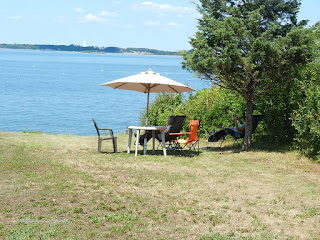Every year
the Hingham Shipyards Marina holds 2 customer appreciation events. It is a chance to have some free wine and
cheese outside with the other boat owners.
The marina has a good number of boats and their owners are from varying
backgrounds.
I have been at HSM for 2
seasons now and met some nice people.
However, on July 2nd 2015 I found myself in a conversation
with one Lester Shapiro. Rather quiet
but a nice man. In our conversation he
mentioned that he was taking his yacht to Sarasota. That got my attention. Then he simply said, “Would you like to join
me”. Well my jaw just about
dropped. What an opportunity! It was just what I was looking for. I had recently received my captain’s license
and now I needed experience. You know
the deal, you need experience to get on a yacht but if you don’t have
experience you can’t get on a yacht. I
just took a breath and said “Absolutely”.
I didn’t know how I was going to make it work but I knew I was going to
be on board.
The morning
we left, the transmission went on my jeep.
Months prior I was told that the transmission needed to be
replaced. I could only call the repair
shop while close enough to the coast and find out what it will cost. I guess that it was good that the repair shop
will have plenty of time to complete the repair.
That said,
we left the dock early on Saturday the 31st of October. Almost right away I was at the wheel of the
Guided Discovery heading out through Hull Gut.
We got off of Hull and set the throttles (1400 rpm) and the Autopilot. There was no need to touch the throttles for
days. Day and night we traveled at 8.4
knots. Using all of the available
electronic equipment such as radar, GPS chart plotter, Autopilot, night vision
camera, sonar and a large spot light we set off for Sarasota Fl.
I napped for
a while on Saturday evening and was ready for the overnight run. I got on the wheel at around 1:30 am and we
had gotten into some 5’ waves. As it
happened, our course had changed slightly.
Due to a dredge project in the Hamptons and a favorable forecast off
shore it was decided to alter our course that would take us out off of NY
harbor entrance. Around 3 am I felt some
motion sickness coming on. When I left
the helm around 5:30 am, it wasn’t getting better. I was sick from about 6 to 8 am. I really felt bad for my shipmates. The sounds that I produced cancelled
breakfast for them too. The seas calmed
down around noon and I was able to get 2 hours sleep. By 3:30 pm I was back on the wheel and
feeling 100%.
On day 2 I
received a text message from my friend who was caring for my 2 yorkies, Asher
and Kalvin. On Thursday and into Friday
before we left, Kalvin developed a case of diarrhea. I had the vet come to my
house on Friday to check him out. She
gave him a saline treatment and a prescription.
She gave me the bill. Now, I get
a photo of the lesion on his back that looks infected. My friend was kind enough to bring Kalvin
back to the vet where he was kept overnight for surgery to remove the cyst on
his back.
On day 3 I
received a text message from my family that our old Aunt Loraine has passed
peacefully the previous night. I knew
that she was failing and was okay to remember the person that I saw at the last
family cook out. The only prudent thing
to do was just say a quite good bye to Aunt Loraine and keep vigilant.
Half way
thru day 4, we pulled in for fuel. By
this time I am evaluating my decision to be a captain. In the first half of my trip I have
experienced a number of things that only other “yachties” really
understand. The very first thing was my
dog, then the jeep, then more dog issues, then the loss of a family
member. At this time I am thinking that
maybe I shouldn’t be on this trip. Then
I am thinking that this is exactly what I should be doing. Things happen that we have no control
over. The only difference is that I am
miles away and at sea. That’s just where
I want to be.
For the
balance of the trip we had a great time, memories that will last forever. The things that I did and saw just leave me
speechless. There is nothing like nature
in the raw. Passing Cape Fear and Frying
Pan Shoals at 3 am was amazing. Cruising
across Lake Okeechobee had a feel of being alone on the lake. Weather lessons from Les, the Okeechobee
Waterway, many locks and bridges, Roland and Mary Ann Martin’s Marina, Dolphins
off of Captiva Island, South Seas Island Resort and turtles in the Gulf of
Mexico are just a few things that make me feel like I should be living on the
water again.
They say
that things happen for a reason. Well I
don’t know what the next chapter in my life will be but I’m open to it and hope
that it will draw on my new skills. And
for the trip to Boston in the spring, it can’t come soon enough. I have to thank Les Shapiro for making this
all possible.



















































